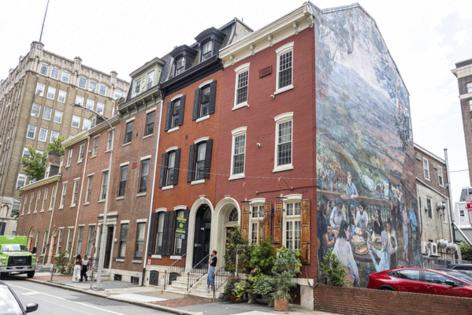Are Philadelphia's historic preservation regulations too strict?
Published in Home and Consumer News
PHILADELPHIA — Jonathan Hessney moved to Philadelphia in 2021, settling his family in a Washington Square West home that dates to the 1970s.
So he was confused when he heard last year that the neighborhood — including many buildings of more recent vintage like his — was becoming a historic district, under the purview of the city’s Historical Commission.
For most people, historic preservation means protecting beautiful old buildings from demolition. But as Hessney learned more about what a historic district entailed, he went from confused to outraged.
Protections would regulate the kinds of doors and windows that could be installed and the placement of solar panels. Many aesthetic changes to exteriors would require more expensive materials and possibly a trip to the Historical Commission for approval.
The notification says “it’s a privilege and an honor to be nominated, but it doesn’t really tell you, by the way, you cannot do anything to the outside of the house without our permission,” Hessney said. “The whole thing just advantages people with the money to hire the fancy architects, the historic consultants, the very expensive contractors.”
The Washington Square West historic district was approved last September at the behest of the local community group and with the support of preservationists across the city.
Despite the Washington Square West Civic Association’s championing of the district, Hessney notes that 133 people wrote to the commission with concerns about the district. Only 23 did so in support.
To the critics, the outcome felt like a forgone conclusion and their objections ignored.
That’s why Hessney and his allies are challenging the historic district designation in Common Pleas Court and have crowdfunded almost $20,000 to help pay for a lawyer.
And they aren’t alone. The last three historic districts approved by the commission are facing legal challenges, the most significant pushback against Philadelphia’s preservation ordinance in 15 years.
“You’re seeing this uptick in appeals because the pendulum swung so far toward preservation without consideration of other public policy factors like affordability,” said Michael Phillips, a real estate lawyer with Klehr Harrison Harvey Branzburg who is representing large property owners challenging the Spruce Hill and Northwest Apartment districts.
For preservationists, the increase in Historical Commission activity is a hard-won victory in the midst of Philadelphia’s recent development boom and an accompanying spate of demolitions, such as the Toll Brothers destruction of a chunk of Jewelers Row.
In neighborhoods like Spruce Hill and Washington Square West, beautiful older buildings have been replaced by drab new construction or nothing at all, as happened when Toll abandoned its proposed housing tower and left a hole in the block.
Historic districts allow much broader protection than saving one irreplaceable structure at a time.
Preservationists argue that the costs of living in a historic district are overblown. The regulations have no effect on the interior of a home. Almost 97% of applications that trigger review are handled by the city’s preservation planners, who can advise on suitable materials, with no trip to the Historical Commission required.
“I don’t want to minimize the homeowners’ issues, but blaming their woes on the historic district is not always accurate,” said Kathy Dowdell, a local preservation advocate and architect. “It’s just more expensive to keep up an old house ... [and in a district,] you can get a tremendous amount of free advice from the Historical Commission staff.”
But critics say regulatory hurdles and often expensive material requirements can burden the average homeowner.
Other American cities have modulated preservation rules, where particularly distinguished districts heavily regulate the exteriors of buildings while others just guard against demolition or other radical changes and don’t dictate details like window style.
Philadelphia’s approach is all or nothing. That means preservationists are increasingly clashing not only with developers and large landlords, but with homeowners and pro-housing groups.
“I’m sympathetic to their argument. Obviously Philadelphia was America’s first capital, and there’s a lot of historic buildings in the city,” said Brennan Maragh, co-chair of urbanist group 5th Square’s Housing Committee. “But designating entire zones of the city as historic as a practice should be strongly discouraged, and momentum is building to push back.”
Ups and downs of preservation in Philly
Designations of individual buildings are often appealed, and in the 2000s, campaigns to create districts in Spruce Hill, Overbrook Farms, and Washington Square West faced opposition.
Both cost-burdened homeowners and large landlords — in fact some of the same student housing companies challenging the current Spruce Hill district — protested to City Council, which threatened the Historical Commission by considering requiring legislative action to protect buildings.
In the wake of the controversy, the Historical Commission largely stopped creating new historic districts for a decade — at a time Philadelphia was experiencing its most dramatic development boom in a half-century.
Many beloved buildings, such as Christian Street Baptist Church in Bella Vista and much of the Boyd Theater in Center City were razed. In response, Mayor Jim Kenney secured a larger budget and more staffers for the Historical Commission.
Now the city has more than twice as many historic districts as there were in 2017, although many of them encompass just a block or two.
Still, critics say preservationists have been overzealous. The Washington Square West district spans from 1740 to 1985. That includes 1,441 properties, although over half of them had already been covered by individual historic protections.
“This is a kitchen-sink historic district; they included everything,” said Matt McClure, a real estate lawyer with Ballard Spahr, who is representing Hessney and other Washington Square West district critics. “It’s absurd.”
A city spokesperson, however, notes that many older Center City historic districts span hundreds of years. “The designation of the Washington Square West district recognizes that the diverse and evolving historical and architectural significance of the area over time is a meaningful part of our city’s story,” a commission spokesperson said in a statement.
That does little to assuage the concerns of the new districts’ critics though. The restrictions can create “significantly increased costs,” said Phillips, who is representing the Lindy family in Northwest Philadelphia, which has long owned apartment complexes in the region, and student housing companies in University City near the University of Pennsylvania.
“Windows, roof tiles, any exterior aspect of maintenance needs to be historically appropriate,” Phillips said. “There’s also the additional cost in red tape of having to go through the commission for any exterior modifications or revisions to homes. And that increases the cost of rent.”
A different way to preserve
Advocates counter that many of the arguments against the new historic districts are the same rhetoric used in Philadelphia’s anti-preservation battles for decades.
“In University City, it’s the same people who’ve objected since it was first proposed in the early ’90s,” said Paul Steinke, executive director of the nonprofit Preservation Alliance of Greater Philadelphia. “That cast of characters really hasn’t changed, nor have their arguments. It’s big libertarian-leaning real estate managers who don’t want to be told what to do.”
Preservationists are used to being the little guy facing big, bad developers. But their arguments are more awkward when it comes to homeowners.
Recent meetings of the commission’s Architectural Committee have seen a trickle of Washington Square West residents arguing about materials required for window or door replacements. They’re frustrated about how much more complicated home repair has become.
“I don’t know anything about this,” one homeowner in Washington Square West said at the July meeting of the commission’s Architectural Committee. “I can’t afford a big custom project.”
Steinke says the more expensive materials are more economical for homeowners in the long run because they have to be replaced less often.
He also argues the regulations — and the added costs — are the price of living in one of America’s most historically significant cities, with one of the largest collections of antiquarian housing in the country.
“They live in a 19th-century house in a city whose brand is its history and its built environment,” Steinke said. “There is a responsibility that comes with that.”
Steinke and other preservationists supported a Kenney administration proposal to create gradations of preservation protection.
In theory, this could allow truly iconic buildings and neighborhoods, like the Custom House or Elfreth’s Alley, to be covered by the strongest regulations. There, solar panels would be banished from sight and window choice closely monitored. But in other historic districts, regulations would be limited to preventing demolition or radical exterior changes like covering brick work with vinyl.
That’s what other old and architecturally significant cities like New Orleans and Boston have done.
“We have different levels of oversight in different neighborhoods,” said Danielle Del Sol, until recently CEO of the Preservation Resource Center of New Orleans. “The French Quarter is the oldest neighborhood in New Orleans, so even a paint color change has to go through city review. … Then you have districts like Uptown that are under partial control and there might just be demolition requests.”
Such a system in Philadelphia could begin to address what critics see as the inequities and overreach of the current preservation system.
It also would give regulators at the commission and the Department of Licenses and Inspections more time to focus on what most people care about: protection of truly notable buildings.
Another possible change, discussed during the Kenney administration, is creating incentives for owners of historic properties, such as a grants to help lower-income homeowners handle additional costs.
“The system has more sticks than carrots,” Dowdell said. “The more people we have in historic districts clamoring for some sort of benefit, the more likely that we’ll finally get some incentives.”
City Councilmember Mark Squilla, whose district includes Washington Square West, says his office is considering policies to ease regulatory and cost burdens on homeowners.
Such policies could come before City Council this autumn, about the time appeals of the recent districts will be heard by the Court of Common Pleas.
“There was discussion of a tiered classification system where not all historic districts are treated the same, so the 700 block of Chestnut Street does not get the same level of protection and oversight as Elfreth’s Alley,” Phillips said. “That could be a positive way to afford the flexibility that’s desperately needed.”
©2025 The Philadelphia Inquirer, LLC. Visit at inquirer.com. Distributed by Tribune Content Agency, LLC.








Comments